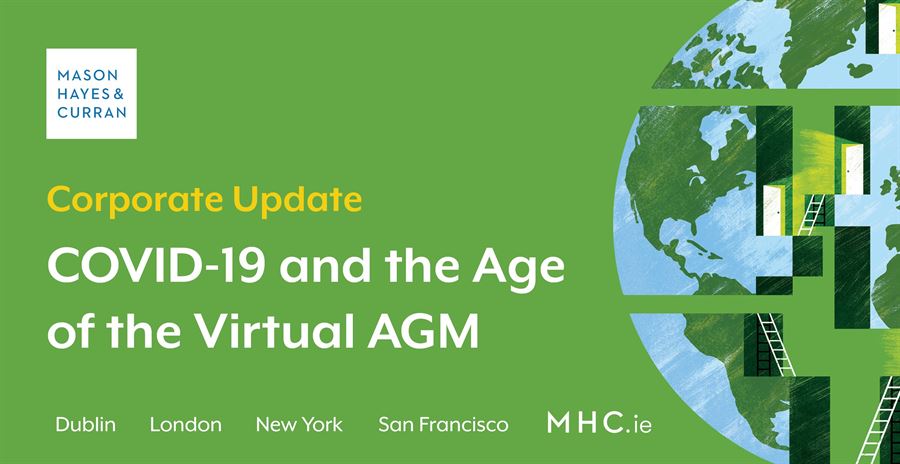
The global pandemic has created organisational headaches for a range of corporate activities in 2020, but particularly for company AGMs. The obligation for Irish companies is to hold an AGM in each year, not more than 15 months apart. For Irish companies, the period in which the global impact of COVID-19 began to be felt was the beginning of what is traditionally AGM season.
A number of Irish companies decided to proceed with their previously scheduled AGMs in Q2 under alternative arrangements and with a restricted attendance (but not without challenge). However, many public and larger private companies were encouraged by the new restrictions to defer AGMs until later in the year.
Time running out for 2020 AGMs
With time running out for these deferred AGMs, the coming into effect of the Companies (Miscellaneous Provisions) (COVID-19) Act 2020 (the Act) comes at an opportune time. The Act implements practical solutions, including a general extension of the time limit for holding AGMs to 31 December 2020, which provide new options and the breathing space for companies to consider them over the remaining months of 2020.
Perhaps the Act’s most noteworthy feature is that it facilitates an Irish company to hold a true virtual general meeting – i.e. a meeting with no physical venue – for the first time. The virtual meeting option is available for an interim period ending on 31 December 2020, but it may be extended.
The Act also provides a facility for directors to cancel a general meeting, change its venue or switch to a virtual meeting, even after the notice has been posted, where in the directors’ opinion it is deemed necessary “for the purposes of preventing, limiting, minimising or slowing the spread of Covid-19”.
Electronic platform
The Act specifies minimum requirements for an electronic platform to host a virtual general meeting. The technology must provide all attendees with a “reasonable opportunity to participate in the meeting”. It must also: provide for the security of any electronic communications by shareholders; minimise the risk of unauthorised access; and provide certainty as to the source of the electronic communications.
In particular, the technology must enable attendees to:
-
Hear what is said by the chairperson and any person addressing the meeting, and
-
Speak and submit questions and comments during the meeting to the chairperson, to the extent that the attendee is entitled to do so under the constitution of the company
On this basis, a video conference facility or audio-only conference call could be used.
Communications security and shareholder identification
As a practical matter, maintaining security and verifying the identities of participants is a particular challenge for virtual meetings. Some of the most commonly used electronic communications platforms (Zoom, Microsoft Teams, Bluejeans, etc.) do not provide default features to guard against unauthorised access and impersonation. For companies with fewer members, each of whom is well known to the organisers, this may not present a difficulty, but this may present a difficulty for companies with wider memberships and well-attended meetings.
To this end, the Act permits companies to make access to the platform subject to such restrictions as are necessary to ensure the identification of shareholders and communication security, provided the restrictions are proportionate.
Voting
The core of any general meeting is voting on resolutions. Members can appoint proxies prior to the meeting to vote on resolutions. However, for the vast majority of companies, resolutions are passed by way of votes cast at the meeting itself, by show of hands or on a poll. Virtual meetings are no exception. This means that a voting mechanism to permit voting at the virtual meeting must be arranged.
It may be feasible for smaller companies to conduct votes by way of a virtual “show of hands”, such as by a roll-call or using the basic poll features of common videoconference applications, since there is little risk of impersonation or fraud. In these cases, the Act permits the chairperson to declare the result of the show of hands “where the chairperson is of the opinion that he or she can identify the members entitled to vote and verify the content of voting instructions relating to the resolution.”
For larger companies, there is a more limited number of software options. These include the specialist virtual meeting software, Lumi, and the commonly used questionnaire application, Surveymonkey, each of which can provide individual logins to facilitate voting security.
In many cases, the simplest option may be to circulate email polling cards to attendees for completion and execution remotely. If necessary, the poll can be conducted after the conclusion of the meeting.
In our view, larger private companies and PLCs will prefer to conduct polls using secure means, since this provides an audit trail in the event that a result is challenged. This choice of voting system will be a crucial concern for such companies.
Conclusion
The Act provides solutions to practical governance issues that have arisen for Irish companies during the pandemic, in particular, providing welcome options for companies to hold AGMs and EGMs by fully or partially virtual means.
Companies holding virtual AGMs and EGMs in 2020 must plan now to address the practical aspects of compliance with the technological and other requirements of the electronic platform that they choose.
On a temporary basis for now, COVID-19 may have ushered in the age of the virtual AGM in Ireland.
For more information on the likely impact of the continued spread of COVID-19 on your organisation, contact a member of our Corporate or Corporate Governance teams.
The content of this article is provided for information purposes only and does not constitute legal or other advice.
Share this:





